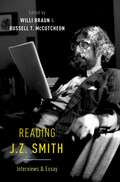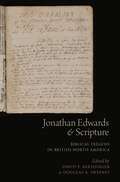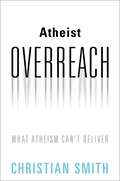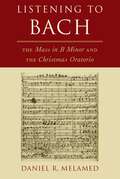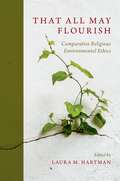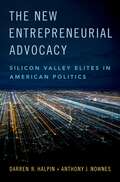- Table View
- List View
The Bundahi%sn: The Zoroastrian Book of Creation
by Domenico Agostini Samuel Thrope Shaul Shaked Guy StroumsaThe Bundahisn, meaning primal or foundational creation, is the central Zoroastrian account of creation, cosmology, and eschatology. Compiled sometime in the ninth century CE, it is one of the most important surviving testaments to Zoroastrian literature in the Middle Persian language and to pre-Islamic Iranian culture. Despite having been composed some two millennia after the Prophet Zoroaster's revelation, it is nonetheless a concise compendium of ancient Zoroastrian knowledge that draws on and reshapes earlier layers of the tradition. Well known in the field of Iranian Studies as an essential primary source for scholars of ancient Iran's history, religions, literatures, and languages, the Bundahisn is also a great work of literature in and of itself, ranking alongside the creation myths of other ancient traditions. The book's thirty-six diverse chapters, which touch on astronomy, eschatology, zoology, medicine, and more, are composed in a variety of styles, registers, and genres, from spare lists and concise commentaries to philosophical discourses and poetic eschatological visions. This new translation, the first in English in nearly a century, highlights the aesthetic quality, literary style, and complexity and raises the profile of pre-Islamic Zoroastrian literature.
The Bundahi%sn: The Zoroastrian Book of Creation
by Domenico Agostini Samuel Thrope Shaul Shaked Guy StroumsaThe Bundahisn, meaning primal or foundational creation, is the central Zoroastrian account of creation, cosmology, and eschatology. Compiled sometime in the ninth century CE, it is one of the most important surviving testaments to Zoroastrian literature in the Middle Persian language and to pre-Islamic Iranian culture. Despite having been composed some two millennia after the Prophet Zoroaster's revelation, it is nonetheless a concise compendium of ancient Zoroastrian knowledge that draws on and reshapes earlier layers of the tradition. Well known in the field of Iranian Studies as an essential primary source for scholars of ancient Iran's history, religions, literatures, and languages, the Bundahisn is also a great work of literature in and of itself, ranking alongside the creation myths of other ancient traditions. The book's thirty-six diverse chapters, which touch on astronomy, eschatology, zoology, medicine, and more, are composed in a variety of styles, registers, and genres, from spare lists and concise commentaries to philosophical discourses and poetic eschatological visions. This new translation, the first in English in nearly a century, highlights the aesthetic quality, literary style, and complexity and raises the profile of pre-Islamic Zoroastrian literature.
Reading J. Z. Smith: Interviews & Essay
Over the course of a career of more than forty years, Jonathan Z. Smith was among the most important voices of critical reflection within the academic study of religion, distinguishing himself as perhaps the most influential theorist of religion of the last half century. Among his significant body of work are essays and lectures on teaching and the essential role of academic scholarship on religion in matters of education and public policy. The interviews and essay published here display something of the dynamic, thinking-on-his feet liveliness that Smith brought to questions about the study of religion, his theoretical preferences, and his methods of teaching. With refreshing candidness and clarity, Reading J.Z. Smith offers an often provocative introduction to discussions on issues that still dominate the complex and continually changing critical conversations in the academic study of religion.
Reading J. Z. Smith: Interviews & Essay
by Willi Braun and Russell T. McCutcheonOver the course of a career of more than forty years, Jonathan Z. Smith was among the most important voices of critical reflection within the academic study of religion, distinguishing himself as perhaps the most influential theorist of religion of the last half century. Among his significant body of work are essays and lectures on teaching and the essential role of academic scholarship on religion in matters of education and public policy. The interviews and essay published here display something of the dynamic, thinking-on-his feet liveliness that Smith brought to questions about the study of religion, his theoretical preferences, and his methods of teaching. With refreshing candidness and clarity, Reading J.Z. Smith offers an often provocative introduction to discussions on issues that still dominate the complex and continually changing critical conversations in the academic study of religion.
JON EDW & SCRIP BIB EXEG BRIT NOR AMER C: Biblical Exegesis in British North America
by David P. Barshinger and Douglas A. SweeneyFor too long, scholars have published new research on Edwards without paying due attention to the work he took most seriously: biblical exegesis. Edwards is recognized as an innovative theologian who wielded tremendous influence on revivalism, evangelicalism, and New England theology. What is often missed is how much time he devoted to studying and understanding the Bible. He kept voluminous notebooks on Scripture and died with unrealized plans for major treatises on the Bible. More and more experts now recognize the importance of this aspect of his life; this book brings together the insights of leading Edwards scholars on this topic. The essays in Jonathan Edwards and Scripture set Edwards' engagement with Scripture in the context of seventeenth-century Protestant exegesis and eighteenth-century colonial interpretation. They provide case studies of Edwards' exegesis in varying genres of the Bible and probe his use of Scripture to develop theology. The authors also set his biblical interpretation in perspective by comparing it with that of other exegetes. This book advances our understanding of the nature and significance of Edwards' work with Scripture and opens new lines of inquiry for students of early modern Western history.
Conversion and the Rehabilitation of the Penal System: A Theological Rereading of Criminal Justice
by Andrew SkotnickiThe Cincinnati Penal Congress of 1870 ushered in the era of "progressive" penology: the use of statistical and social scientific methodologies, commitment to psychiatric and therapeutic interventions, and a new innovation--the reformatory--as the locus for the application of these initiatives. The prisoner was now seen as a specimen to be analyzed, treated, and properly socialized into the triumphal current of American social and economic life. The Progressive rehabilitative initiatives succumbed in the 1970s to withering criticism from the proponents of equally futile strategies for addressing "the crime problem": retribution, deterrence, and selective incapacitation. The early Christian community developed a methodology for correcting human error that featured the unprecedented belief that a period of time spent in a given penitential locale, with the aid and encouragement of the community, was sufficient in and of itself to heal the alienation and self-loathing caused by sin and to lead an individual to full reincorporation into the community. The "correctional" practice was based upon the conviction that cooperative sociability--or conversion--is possible, regardless of the specific offense, without any need to inflict suffering, or to use the act of punishment as a warning to potential offenders, or to undertake programmatic interventions into the lives of the incarcerated for the purpose of rehabilitating them. Andrew Skotnicki contends that the modern practice of criminal detention is a protracted exercise in needless violence predicated upon two foundational errors. The first is an inability to see the imprisoned as human beings fully capable of responding to an affirmative accompaniment rather than maltreatment and invasive forms of therapy. The second is a pervasive dualism that constructs a barrier between detainees and those empowered to supervise, rehabilitate, and punish them. In this book, Skotnicki argues that the criminal justice system can only be rehabilitated by eliminating punishment and policies based upon deterrence, rehabilitation, and the incapacitation of the urban poor and returning to the original justification for the practice of confinement: conversion.
Conversion and the Rehabilitation of the Penal System: A Theological Rereading of Criminal Justice
by Andrew SkotnickiThe Cincinnati Penal Congress of 1870 ushered in the era of "progressive" penology: the use of statistical and social scientific methodologies, commitment to psychiatric and therapeutic interventions, and a new innovation--the reformatory--as the locus for the application of these initiatives. The prisoner was now seen as a specimen to be analyzed, treated, and properly socialized into the triumphal current of American social and economic life. The Progressive rehabilitative initiatives succumbed in the 1970s to withering criticism from the proponents of equally futile strategies for addressing "the crime problem": retribution, deterrence, and selective incapacitation. The early Christian community developed a methodology for correcting human error that featured the unprecedented belief that a period of time spent in a given penitential locale, with the aid and encouragement of the community, was sufficient in and of itself to heal the alienation and self-loathing caused by sin and to lead an individual to full reincorporation into the community. The "correctional" practice was based upon the conviction that cooperative sociability--or conversion--is possible, regardless of the specific offense, without any need to inflict suffering, or to use the act of punishment as a warning to potential offenders, or to undertake programmatic interventions into the lives of the incarcerated for the purpose of rehabilitating them. Andrew Skotnicki contends that the modern practice of criminal detention is a protracted exercise in needless violence predicated upon two foundational errors. The first is an inability to see the imprisoned as human beings fully capable of responding to an affirmative accompaniment rather than maltreatment and invasive forms of therapy. The second is a pervasive dualism that constructs a barrier between detainees and those empowered to supervise, rehabilitate, and punish them. In this book, Skotnicki argues that the criminal justice system can only be rehabilitated by eliminating punishment and policies based upon deterrence, rehabilitation, and the incapacitation of the urban poor and returning to the original justification for the practice of confinement: conversion.
Atheist Overreach: What Atheism Can't Deliver
by Christian SmithIn recent years atheism has become ever more visible, acceptable, and influential. Atheist apologists have become increasingly vociferous and confident in their claims: that a morality requiring benevolence towards all and universal human rights need not be grounded in religion; that modern science disproves the existence of God; and that there is nothing innately religious about human beings. In Atheist Overreach, Christian Smith takes a look at the evidence and arguments, and explains why we ought to be skeptical of these atheists' claims about morality, science, and human nature. He does not argue that atheism is necessarily wrong, but rather that its advocates are advancing crucial claims that are neither rationally defensible nor realistic. Their committed worldview feeds unhelpful arguments and contributes to the increasing polarization of today's political landscape. Everyone involved in the theism-atheism debates, in shared moral reflection, and in the public consumption of the findings of science should be committed to careful reasoning and rigorous criticism. This book provides readers with the information they need to participate more knowledgably in debates about atheism and what it means for our society.
Atheist Overreach: What Atheism Can't Deliver
by Christian SmithIn recent years atheism has become ever more visible, acceptable, and influential. Atheist apologists have become increasingly vociferous and confident in their claims: that a morality requiring benevolence towards all and universal human rights need not be grounded in religion; that modern science disproves the existence of God; and that there is nothing innately religious about human beings. In Atheist Overreach, Christian Smith takes a look at the evidence and arguments, and explains why we ought to be skeptical of these atheists' claims about morality, science, and human nature. He does not argue that atheism is necessarily wrong, but rather that its advocates are advancing crucial claims that are neither rationally defensible nor realistic. Their committed worldview feeds unhelpful arguments and contributes to the increasing polarization of today's political landscape. Everyone involved in the theism-atheism debates, in shared moral reflection, and in the public consumption of the findings of science should be committed to careful reasoning and rigorous criticism. This book provides readers with the information they need to participate more knowledgably in debates about atheism and what it means for our society.
Escaped Nuns: True Womanhood and the Campaign Against Convents in Antebellum America
by Cassandra L. YacovazziJust five weeks after its publication in January 1836, Awful Disclosures of the Hotel Dieu Nunnery, billed as an escaped nun's shocking exposé of convent life, had already sold more than 20,000 copies. The book detailed gothic-style horror stories of licentious priests and abusive mothers superior, tortured nuns and novices, and infanticide. By the time the book was revealed to be a fiction and the author, Maria Monk, an imposter, it had already become one of the nineteenth century's best-selling books. In antebellum America only one book, Uncle Tom's Cabin, outsold it. The success of Monk's book was no fluke, but rather a part of a larger phenomenon of anti-Catholic propaganda, riots, and nativist politics. The secrecy of convents stood as an oblique justification for suspicion of Catholics and the campaigns against them, which were intimately connected with cultural concerns regarding reform, religion, immigration, and, in particular, the role of women in the Republic. At a time when the term "female virtue" pervaded popular rhetoric, the image of the veiled nun represented a threat to the established American ideal of womanhood. Unable to marry, she was instead a captive of a foreign foe, a fallen woman, a white slave, and a foolish virgin. In the first half of the nineteenth century, ministers, vigilantes, politicians, and writers--male and female--forged this image of the nun, locking arms against convents. The result was a far-reaching antebellum movement that would shape perceptions of nuns, and women more broadly, in America.
Escaped Nuns: True Womanhood and the Campaign Against Convents in Antebellum America
by Cassandra L. YacovazziJust five weeks after its publication in January 1836, Awful Disclosures of the Hotel Dieu Nunnery, billed as an escaped nun's shocking exposé of convent life, had already sold more than 20,000 copies. The book detailed gothic-style horror stories of licentious priests and abusive mothers superior, tortured nuns and novices, and infanticide. By the time the book was revealed to be a fiction and the author, Maria Monk, an imposter, it had already become one of the nineteenth century's best-selling books. In antebellum America only one book, Uncle Tom's Cabin, outsold it. The success of Monk's book was no fluke, but rather a part of a larger phenomenon of anti-Catholic propaganda, riots, and nativist politics. The secrecy of convents stood as an oblique justification for suspicion of Catholics and the campaigns against them, which were intimately connected with cultural concerns regarding reform, religion, immigration, and, in particular, the role of women in the Republic. At a time when the term "female virtue" pervaded popular rhetoric, the image of the veiled nun represented a threat to the established American ideal of womanhood. Unable to marry, she was instead a captive of a foreign foe, a fallen woman, a white slave, and a foolish virgin. In the first half of the nineteenth century, ministers, vigilantes, politicians, and writers--male and female--forged this image of the nun, locking arms against convents. The result was a far-reaching antebellum movement that would shape perceptions of nuns, and women more broadly, in America.
Listening to Bach: The Mass in B Minor and the Christmas Oratorio
by Daniel R. MelamedOf all the things we can know about J. S. Bach's Mass in B Minor and Christmas Oratorio, the most profound come from things we can hear. Listening to Bach explores musical style as it was understood in the early eighteenth century. It encourages ways of listening that take eighteenth-century musical sensibilities into account and that recognize our place as inheritors of a long tradition of performance and interpretation. Daniel R. Melamed shows how to recognize old and new styles in sacred music of Bach's time, and how movements in these styles are constructed. This opens the possibility of listening to the Mass in B Minor as Bach's demonstration of the possibilities of contrasting, combining, and reconciling old and new styles. It also shows how to listen for elements that would have been heard as most significant in the early eighteenth century, including markers of sleep arias, love duets, secular choral arias, and other movement types. This offers a musical starting point for listening for the ways Bach put these types to use in the Mass in B Minor and the Christmas Oratorio. The book also offers ways to listen to and think about works created by parody, the re-use of music for new words and a new purpose, like almost all of the Mass in B Minor and Christmas Oratorio. And it shows that modern performances of these works are stamped with audible consequences of our place in the twenty-first century. The ideological choices we make in performing the Mass and Oratorio, part of the legacy of their performance and interpretation, affect the way the work is understood and heard today. All these topics are illustrated with copious audio examples on a companion Web site, offering new ways of listening to some of Bach's greatest music.
Listening to Bach: The Mass in B Minor and the Christmas Oratorio
by Daniel R. MelamedOf all the things we can know about J. S. Bach's Mass in B Minor and Christmas Oratorio, the most profound come from things we can hear. Listening to Bach explores musical style as it was understood in the early eighteenth century. It encourages ways of listening that take eighteenth-century musical sensibilities into account and that recognize our place as inheritors of a long tradition of performance and interpretation. Daniel R. Melamed shows how to recognize old and new styles in sacred music of Bach's time, and how movements in these styles are constructed. This opens the possibility of listening to the Mass in B Minor as Bach's demonstration of the possibilities of contrasting, combining, and reconciling old and new styles. It also shows how to listen for elements that would have been heard as most significant in the early eighteenth century, including markers of sleep arias, love duets, secular choral arias, and other movement types. This offers a musical starting point for listening for the ways Bach put these types to use in the Mass in B Minor and the Christmas Oratorio. The book also offers ways to listen to and think about works created by parody, the re-use of music for new words and a new purpose, like almost all of the Mass in B Minor and Christmas Oratorio. And it shows that modern performances of these works are stamped with audible consequences of our place in the twenty-first century. The ideological choices we make in performing the Mass and Oratorio, part of the legacy of their performance and interpretation, affect the way the work is understood and heard today. All these topics are illustrated with copious audio examples on a companion Web site, offering new ways of listening to some of Bach's greatest music.
The Mindful Elite: Mobilizing from the Inside Out
by Jaime KucinskasMindful meditation is now embraced in virtually all corners of society today, from K-12 schools to Fortune 100 companies, and its virtues extolled by national and international media almost daily. It is thought to benefit our health and overall well-being, to counter stress, to help children pay attention, and to foster creativity, productivity and emotional intelligence. Yet in the 1960s and 1970s meditation was viewed as a marginal, counter-cultural practice, or a religious ritual for Asian immigrants. How did mindfulness become mainstream? In The Mindful Elite, Jaime Kucinskas reveals who is behind the mindfulness movement, and the engine they built to propel mindfulness into public consciousness. Drawing on over a hundred first-hand accounts with top scientists, religious leaders, educators, business people and investors, Kucinskas shows how this highly accomplished, affluent group in America transformed meditation into an appealing set of contemplative practices. Rather than relying on confrontation and protest to make their mark and improve society, the contemplatives sought a cultural revolution by building elite networks and advocating the benefits of meditation across professions. Yet, spreading the Dharma far and wide came with unintended consequences and this idealistic myopia came to reinforce some of the problems it originally aspired to solve. A critical look at this Buddhist-inspired movement, The Mindful Elite explores how elite movements can spread and draws larger lessons for other social, cultural, and religious movements across institutions and organizations.
The Mindful Elite: Mobilizing from the Inside Out
by Jaime KucinskasMindful meditation is now embraced in virtually all corners of society today, from K-12 schools to Fortune 100 companies, and its virtues extolled by national and international media almost daily. It is thought to benefit our health and overall well-being, to counter stress, to help children pay attention, and to foster creativity, productivity and emotional intelligence. Yet in the 1960s and 1970s meditation was viewed as a marginal, counter-cultural practice, or a religious ritual for Asian immigrants. How did mindfulness become mainstream? In The Mindful Elite, Jaime Kucinskas reveals who is behind the mindfulness movement, and the engine they built to propel mindfulness into public consciousness. Drawing on over a hundred first-hand accounts with top scientists, religious leaders, educators, business people and investors, Kucinskas shows how this highly accomplished, affluent group in America transformed meditation into an appealing set of contemplative practices. Rather than relying on confrontation and protest to make their mark and improve society, the contemplatives sought a cultural revolution by building elite networks and advocating the benefits of meditation across professions. Yet, spreading the Dharma far and wide came with unintended consequences and this idealistic myopia came to reinforce some of the problems it originally aspired to solve. A critical look at this Buddhist-inspired movement, The Mindful Elite explores how elite movements can spread and draws larger lessons for other social, cultural, and religious movements across institutions and organizations.
Antoine de Chandieu: The Silver Horn of Geneva's Reformed Triumvirate (Oxford Studies in Historical Theology)
by Theodore G. Van RaalteOffering the first study in any language dedicated to the influential publications of the French Reformed theologian Antoine de Chandieu (1534-1591), Theodore Van Raalte begins by recalling Chandieu's reputation as it stood at the death of Theodore Beza in 1605. Poets in Geneva mourned the end of an era of star theologians, reminiscing about Geneva's Reformed triumvirate of gold, silver, and bronze: gold represented Calvin; silver Chandieu; and bronze Beza. Van Raalte's work sets Chandieu within the context of Reformed theology in Geneva, the wider history of scholastic method in the Swiss cantons, and the gripping social and political milieux of this tumultuous time. Chandieu was far from a mere ivory tower theologian: as a member of French nobility in possession of many estates and castles in France, he and his family acutely experienced the misery and triumph of the French Huguenots during the Wars of Religion. Connected to royalty from the beginning of his career, Chandieu later served the future Henry IV as personal military chaplain and cryptographer. His writings run the gamut from religious poetry (put to music by others in his lifetime) to carefully-crafted disputations which saw publication in his posthumous Opera Theologica in five editions between 1592 and 1620. Chandieu had developed a very elaborate form of the medieval quaestio disputata and made liberal use of hypothetical syllogisms. Van Raalte argues that Chandieu utilized scholastic method in theology for the sake of clarity of argument, rootedness in Scripture, and certainty of faith.
Antoine de Chandieu: The Silver Horn of Geneva's Reformed Triumvirate (Oxford Studies in Historical Theology)
by Theodore G. Van RaalteOffering the first study in any language dedicated to the influential publications of the French Reformed theologian Antoine de Chandieu (1534-1591), Theodore Van Raalte begins by recalling Chandieu's reputation as it stood at the death of Theodore Beza in 1605. Poets in Geneva mourned the end of an era of star theologians, reminiscing about Geneva's Reformed triumvirate of gold, silver, and bronze: gold represented Calvin; silver Chandieu; and bronze Beza. Van Raalte's work sets Chandieu within the context of Reformed theology in Geneva, the wider history of scholastic method in the Swiss cantons, and the gripping social and political milieux of this tumultuous time. Chandieu was far from a mere ivory tower theologian: as a member of French nobility in possession of many estates and castles in France, he and his family acutely experienced the misery and triumph of the French Huguenots during the Wars of Religion. Connected to royalty from the beginning of his career, Chandieu later served the future Henry IV as personal military chaplain and cryptographer. His writings run the gamut from religious poetry (put to music by others in his lifetime) to carefully-crafted disputations which saw publication in his posthumous Opera Theologica in five editions between 1592 and 1620. Chandieu had developed a very elaborate form of the medieval quaestio disputata and made liberal use of hypothetical syllogisms. Van Raalte argues that Chandieu utilized scholastic method in theology for the sake of clarity of argument, rootedness in Scripture, and certainty of faith.
She Preached the Word: Women's Ordination in Modern America
by Benjamin R. Knoll Cammie Jo BolinShe Preached the Word is a landmark study of women's ordination in contemporary American congregations. In this groundbreaking work, Benjamin R. Knoll and Cammie Jo Bolin draw upon a novel collection of survey data and personal narrative interviews to answer several important questions, including: Who supports women's ordination in their congregations? What are the most common reasons for and against women's ordination? What effect do female clergy have on young women and girls, particularly in terms of their psychological, economic, and religious empowerment later in life? How do women clergy affect levels of congregational attendance and engagement among members? What explains the persistent gender gap in America's clergy? Knoll and Bolin find that female clergy do indeed matter, but not always in the ways that might be expected. They show, for example, that while female clergy have important effects on women in the pews, they have stronger effects on theological and political liberals. Throughout this book, Knoll and Bolin discuss how the persistent gender gap in the wider economic, social, and political spheres will likely continue so long as women are underrepresented in America's pulpits. Accessible to scholars and general readers alike, She Preached the Word is a timely and important contribution to our understanding of the intersection of gender, religion, and politics in contemporary American society.
She Preached the Word: Women's Ordination in Modern America
by Benjamin R. Knoll Cammie Jo BolinShe Preached the Word is a landmark study of women's ordination in contemporary American congregations. In this groundbreaking work, Benjamin R. Knoll and Cammie Jo Bolin draw upon a novel collection of survey data and personal narrative interviews to answer several important questions, including: Who supports women's ordination in their congregations? What are the most common reasons for and against women's ordination? What effect do female clergy have on young women and girls, particularly in terms of their psychological, economic, and religious empowerment later in life? How do women clergy affect levels of congregational attendance and engagement among members? What explains the persistent gender gap in America's clergy? Knoll and Bolin find that female clergy do indeed matter, but not always in the ways that might be expected. They show, for example, that while female clergy have important effects on women in the pews, they have stronger effects on theological and political liberals. Throughout this book, Knoll and Bolin discuss how the persistent gender gap in the wider economic, social, and political spheres will likely continue so long as women are underrepresented in America's pulpits. Accessible to scholars and general readers alike, She Preached the Word is a timely and important contribution to our understanding of the intersection of gender, religion, and politics in contemporary American society.
Household Gods: The Religious Lives of the Adams Family
by Sara GeorginiReflecting on his past, President John Adams mused that it was religion that had shaped his family's fortunes and young America's future. For the nineteenth century's first family, the Adamses of Massachusetts, the history of how they lived religion was dynamic and well-documented. Christianity supplied the language that Abigail used to interpret husband John's political setbacks. Scripture armed their son John Quincy to act as father, statesman, and antislavery advocate. Unitarianism gave Abigail's Victorian grandson, Charles Francis, the religious confidence to persevere in political battles on the Civil War homefront. By contrast, his son Henry found religion hollow and repellent compared to the purity of modern science. A renewal of faith led Abigail's great-grandson Brooks, a Gilded Age critic of capitalism, to prophesy two world wars. Globetrotters who chronicled their religious journeys extensively, the Adamses ultimately developed a cosmopolitan Christianity that blended discovery and criticism, faith and doubt. Drawing from their rich archive, Sara Georgini, series editor for The Papers of John Adams, demonstrates how pivotal Christianity--as the different generations understood it--was in shaping the family's decisions, great and small. Spanning three centuries of faith from Puritan New England to the Jazz Age, Household Gods tells a new story of American religion, as the Adams family lived it.
Household Gods: The Religious Lives of the Adams Family
by Sara GeorginiReflecting on his past, President John Adams mused that it was religion that had shaped his family's fortunes and young America's future. For the nineteenth century's first family, the Adamses of Massachusetts, the history of how they lived religion was dynamic and well-documented. Christianity supplied the language that Abigail used to interpret husband John's political setbacks. Scripture armed their son John Quincy to act as father, statesman, and antislavery advocate. Unitarianism gave Abigail's Victorian grandson, Charles Francis, the religious confidence to persevere in political battles on the Civil War homefront. By contrast, his son Henry found religion hollow and repellent compared to the purity of modern science. A renewal of faith led Abigail's great-grandson Brooks, a Gilded Age critic of capitalism, to prophesy two world wars. Globetrotters who chronicled their religious journeys extensively, the Adamses ultimately developed a cosmopolitan Christianity that blended discovery and criticism, faith and doubt. Drawing from their rich archive, Sara Georgini, series editor for The Papers of John Adams, demonstrates how pivotal Christianity--as the different generations understood it--was in shaping the family's decisions, great and small. Spanning three centuries of faith from Puritan New England to the Jazz Age, Household Gods tells a new story of American religion, as the Adams family lived it.
THAT ALL MAY FLOURISH C: Comparative Religious Environmental Ethics
by Laura M. HartmanCan humans flourish without destroying the earth? In this book, experts on many of the world's major and minor religious traditions address the question of human and earth flourishing. Each chapter considers specific religious ideas and specific environmental harms. Chapters are paired and the authors work in dialogue with one another. Taken together, the chapters reveal that the question of flourishing is deceptively simple. Most would agree that humans should flourish without destroying the earth. But not all humans have equal opportunities to flourish. Additionally, on a basic physical level any human flourishing must, of necessity, cause some harm. These considerations of the price and distribution of flourishing raise unique questions about the status of humans and nature. This book represents a step toward reconciliation: that people and their ecosystems may live in peace, that people from different religious worldviews may engage in productive dialogue; in short, that all may flourish.
Exporting the Rapture: John Nelson Darby And The Victorian Conquest Of North-american Evangelicalism
by Donald Harman AkensonExporting the Rapture: John Nelson Darby And The Victorian Conquest Of North-american Evangelicalism
by Donald Harman AkensonThe New Entrepreneurial Advocacy: Silicon Valley Elites in American Politics
by Darren R. Halpin Anthony J. NownesThe role of business in American politics has provoked much controversy and attention over recent years. One need look no further than the Koch brothers or the Trump administration to get an idea of the extent to which the interests of private business wield influence over the political system. Contemporary evidence of the clear and growing disparities in wealth between ordinary citizens and business elites has drawn new attention to this topic. Recently, the canon on the activities of business elites in politics has also grown as we have learned a great deal about how business firms and their ultra-wealthy leaders and investors seek to exert political influence. This book looks at one form of business elite activity that has thus far received little attention, despite the high-profile political efforts of billionaire businesspeople including Bill Gates, Elon Musk, and Mark Zuckerberg: a phenomenon that Darren R. Halpin and Anthony J. Nownes call new entrepreneurial advocacy. This "entrepreneurial advocacy" is a mode of political engagement in which wealthy entrepreneurs (often from Silicon Valley) use their vast resources to form new organizations that advocate for their vision of the social good, which may or may not be directly linked to their private or business interests. While previous studies focus on a cross section of either the wealthiest Americans or the largest firms in the United States, this book takes a deep-dive into the political activities of a single, yet pivotal, cohort--the founders and CEOs of Silicon Valley firms. Specifically, the authors trace the development of new entrepreneurial advocacy to understand its extent, its breadth, and whose interests they represent, who supports them financially, and why business elites choose to create new organizations to engage in advocacy rather than do so under the umbrellas of their companies. Crucially, the authors also look at the impact of these organizations and what their activity means for American democracy. Leveraging a vast range of unique datasets, from political donations and lobbying to philanthropic giving and social media commentary, this book examines the role of this important set of elites in contemporary American political life.

